Art of the United Kingdom

The Art of the United Kingdom refers to all forms of visual art in or associated with the
Increased British prosperity at the time led to a greatly increased production of both
The training of artists, which had long been neglected, began to improve in the 18th century through private and government initiatives, and greatly expanded in the 19th century. Public exhibitions and the later opening of museums brought art to a wider public, especially in London. In the 19th century publicly displayed religious art once again became popular after a virtual absence since the Reformation, and, as in other countries, movements such as the Pre-Raphaelite Brotherhood and the Glasgow School contended with established Academic art.
The British contribution to early
Background
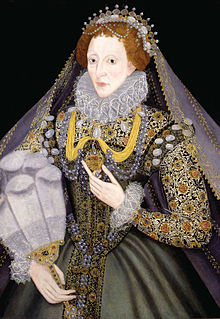
The oldest surviving British art includes
The English contribution to
The
Landscape painting was as yet little developed in Britain at the time of the Union, but a tradition of marine art had been established by the father and son both called Willem van de Velde, who had been the leading Dutch maritime painters until they moved to London in 1673, in the middle of the Third Anglo-Dutch War.[3]
Early 18th century

The so-called Acts of Union 1707 came in the middle of the long period of domination in London of Sir Godfrey Kneller, a German portraitist who had eventually succeeded as principal court painter the Dutch Sir Peter Lely, whose style he had adopted for his enormous and formulaic output, of greatly varying quality, which was itself repeated by an army of lesser painters. His counterpart in Edinburgh, Sir John Baptist Medina, born in Brussels to Spanish parents, had died just before the Union took place, and was one of the last batch of Scottish knights to be created. Medina had first worked in London, but in mid-career moved to the less competitive environment of Edinburgh, where he dominated portraiture of the Scottish elite. However, after the Union the movement was to be all in the other direction, and Scottish aristocrats resigned themselves to paying more to have their portraits painted in London, even if by Scottish painters such as Medina's pupil William Aikman, who moved down in 1723, or Allan Ramsay.[4]
There was an alternative, more direct, tradition in British portraiture to that of Lely and Kneller, tracing back to William Dobson and the German or Dutch
An exception to the dominance of the "
From 1714 the new Hanoverian dynasty conducted a far less ostentatious court, and largely withdrew from patronage of the arts, other than the necessary portraits. Fortunately, the booming British economy was able to supply aristocratic and mercantile wealth to replace the court, above all in London.[8]
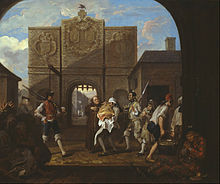
Like many later painters Hogarth wanted above all to achieve success at

There was a recognition that, even more than the rest of Europe given the lack of British artists, the training of artists needed to be extended beyond the workshop of established masters, and various attempts were made to set up
The Scottish portraitist Allan Ramsay worked in Edinburgh before moving to London by 1739. He made visits of three years to Italy at the beginning and end of his career, and anticipated Joshua Reynolds in bringing a more relaxed version of "Grand Manner" to British portraiture, combined with very sensitive handling in his best work, which is generally agreed to have been of female sitters. His main London rival in the mid-century, until Reynolds made his reputation, was Reynold's master, the stodgy Thomas Hudson.[11]
-
Sir John Rushout, 4th Baronet, by Godfrey Kneller, 1716
-
William Hogarth, Marriage A-la-Mode (Hogarth), c. 1743-45
-
Thomas Hudson, Portrait of John Byng, 1749
The
From his arrival in London in 1720, the Flemish sculptor
The strong London
Unlike in France and Germany, the English adoption of the Rococo style was patchy rather than whole-hearted, and there was resistance to it on nationalist grounds, led by
Late 18th century
In the modern popular mind, English art from about 1750–1790 — today referred to as the "classical age" of English painting — was dominated by Sir Joshua Reynolds (1723–1792), George Stubbs (1724–1806), Thomas Gainsborough (1727–1788) and Joseph Wright of Derby (1734–1797). At the time Reynolds was considered the dominant figure, Gainsborough was very highly reputed, but Stubbs was seen as a mere painter of animals and viewed as far a less significant figure than many other painters that are today little-known or forgotten. The period saw continued rising prosperity for Britain and British artists: "By the 1780s English painters were among the wealthiest men in the country, their names familiar to newspaper readers, their quarrels and cabals the talk of the town, their subjects known to everyone from the displays in the print-shop windows", according to Gerald Reitlinger.[21]
Reynolds returned from a long visit to Italy in 1753, and very quickly established a reputation as the most fashionable London portraitist, and before long as a formidable figure in society;, the public leader of the arts in Britain. He had studied both classical and modern Italian art, and his compositions discreetly re-use models seen on his travels. He could convey a wide range of moods and emotions, whether heroic military men or very young women, and often to unite background and figure in a dramatic way.[22]
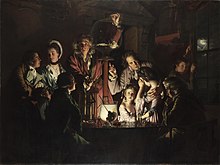
The
After the academy was established, Reynolds' portraits became more overly classicizing, and often more distant, until in the late 1770s he returned to a more intimate style, perhaps influenced by the success of

The Welsh painter
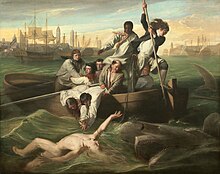
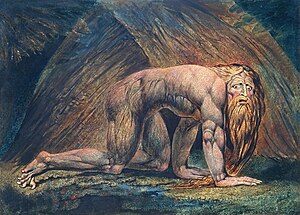
Paintings recording scenes from the theatre were another subgenre, painted by the German

Thomas Rowlandson produced watercolours and prints satirizing British life, but mostly avoided politics. The master of the political caricature, sold individually by print shops (often acting as publishers also), either hand-coloured or plain, was James Gillray.[34] The emphasis on portrait-painting in British art was not entirely due to the vanity of the sitters. There was a large collector's market for portrait prints, mostly reproductions of paintings, which were often mounted in albums. From the mid-century there was a great growth in the expensive but more effective reproductions in mezzotint, of portraits and other paintings, with special demand from collectors for early proof states "before letter" (that is, before the inscriptions were added), which the printmakers obligingly printed off in growing numbers.[35]
This period marked one of the high points in British decorative arts. Around the mid-century many
The three leading furniture makers,
-
Sir Joshua Reynolds, Self-portrait, aged about 24 c. 1747-9
-
George Stubbs, Whistlejacket, c. 1762
-
Sir Joshua Reynolds, The Ladies Waldegrave, 1780–81
-
Sir Joshua Reynolds, The Age of Innocence, 1785–88
19th century and the Romantics
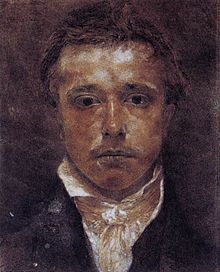
The late 18th century and the early 19th century characterized by the
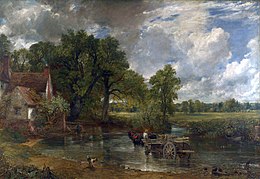
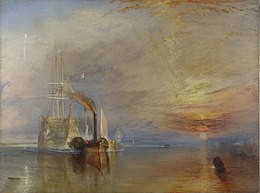
Blake's visionary style was a minority taste in his lifetime, but influenced the younger group of "
John Flaxman was the most thorough-going neo-classical English artist. Beginning as a sculptor, he became best known for his many spare "outline drawings" of classical scenes, often illustrating literature, which were reproduced as prints. These imitated the effects of the classical-style reliefs he also produced. The German-Swiss Henry Fuseli also produced work in a linear graphic style, but his narrative scenes, often from English literature, were intensely Romantic and highly dramatic.[50]
-
William Blake, Newton, 1805
-
John Constable, The White Horse, 1819
-
J. M. W. Turner, The Slave Ship, 1840
-
J. M. W. Turner, The Rigi, 1842
Victorian art
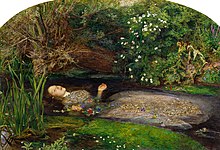
The Pre-Raphaelite Brotherhood (PRB) achieved considerable influence after its foundation in 1848 with paintings that concentrated on religious, literary, and genre subjects executed in a colourful and minutely detailed style, rejecting the loose painterly brushwork of the tradition represented by "Sir Sloshua" Reynolds. PRB artists included John Everett Millais, William Holman Hunt, Dante Gabriel Rossetti, and Ford Madox Brown (never officially a member), and figures such as Edward Burne-Jones and John William Waterhouse were later much influenced by aspects of their ideas, as was the designer William Morris. Morris advocated a return to hand-craftsmanship in the decorative arts over the industrial manufacture that was rapidly being applied to all crafts. His efforts to make beautiful objects affordable (or even free) for everyone led to his wallpaper and tile designs defining the Victorian aesthetic and instigating the Arts and Crafts movement.
The Pre-Raphaelites, like Turner, were supported by the authoritative art critic John Ruskin, himself a fine amateur artist. For all their technical innovation, they were both traditional and Victorian in their adherence to the history painting as the highest form of art, and their subject matter was thoroughly in tune with Victorian taste, and indeed "everything that the publishers of steel engravings welcomed",[51] enabling them to merge easily into the mainstream in their later careers.[52]
While the Pre-Raphaelites had a turbulent and divided reception, the most popular and expensive painters of the period included
During the late Victorian era in Britain the academic paintings, some enormously large, of
For all such artists the

British history was a very common subject, with the Middle Ages, Elizabeth I, Mary, Queen of Scots and the English Civil War especially popular sources for subjects. Many painters mentioned elsewhere painted historical subjects, including Millais (The Boyhood of Raleigh and many others), Ford Madox Brown (Cromwell on his Farm), David Wilkie, Watts and Frith, and West, Bonington and Turner in earlier decades. The London-based Irishman Daniel Maclise and Charles West Cope painted scenes for the new Palace of Westminster. Lady Jane Grey was, like Mary Queen of Scots, a female whose sufferings attracted many painters, though none quite matched The Execution of Lady Jane Grey, one of many British historical subjects by the Frenchman Paul Delaroche.[57] Painters prided themselves on the increasing accuracy of their period settings in terms of costume and objects, studying the collections of the new Victoria and Albert Museum and books, and scorning the breezy approximations of earlier generations of artists.[58]

Victorian painting developed the Hogarthian social subject, packed with moralizing detail, and the tradition of illustrating scenes from literature, into a range of types of genre painting, many with only a few figures, others large and crowded scenes like Frith's best-known works. Holman Hunt's
Towards the end of the 19th century the problem picture left the details of the narrative action deliberately ambiguous, inviting the viewer to speculate on it using the evidence in front of them, but not supplying a final answer (artists learned to smile enigmatically when asked). This sometimes provoked discussion on sensitive social issues, typically involving women, that might have been hard to raise directly. They were enormously popular; newspapers ran competitions for readers to supply the meaning of the painting.[60]
Many artists participated in the revival of original artistic
British
Larger paintings concerned with the social conditions of the poor tended to concentrate on rural scenes, so that the misery of the human figures was at least offset by a landscape. Painters of these included Frederick Walker, Luke Fildes (although he made his name in 1874 with Applicants for Admission to a Casual Ward- see above), Frank Holl, George Clausen, and the German Hubert von Herkomer.[64]
William Bell Scott, a friend of the Rossettis, painted historical scenes and other types of work, but was also one of the few artists to depict scenes from heavy industry. His memoirs are a useful source for the period, and he was one of several artists to be employed for a period in the greatly expanded system of government art schools, which were driven by the administrator Henry Cole (the inventor of the Christmas card) and employed Richard Redgrave, Edward Poynter, Richard Burchett, the Scottish designer Christopher Dresser and many others. Burchett was headmaster of the "South Kensington Schools", now the Royal College of Art, which gradually replaced the Royal Academy School as the leading British art school, though around the start of the 20th century the Slade School of Fine Art produced many of the forward-looking artists.[65]
The Royal Academy was initially by no means as conservative and restrictive as the
Alfred Sisley, who was French by birth but had British nationality, painted in France as one of the Impressionists; Walter Sickert and Philip Wilson Steer at the start of their careers were also strongly influenced, but despite the dealer Paul Durand-Ruel bringing many exhibitions to London, the movement made little impact in England until decades later.[66] Some members of the Newlyn School of landscapes and genre scenes adopted a quasi-Impressionist technique while others used realist or more traditional levels of finish.
The late 19th century also saw the
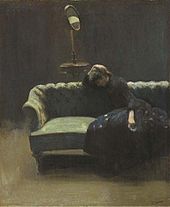
Scottish art was now regaining an adequate home market, allowing it to develop a distinctive character, of which the "
New printing technology brought a great expansion in book illustration with illustrations for
The experience of military, political and economic power from the rise of the British Empire, led to a very specific drive in artistic technique, taste and sensibility in the United Kingdom.[71] British people used their art "to illustrate their knowledge and command of the natural world", whilst the permanent settlers in British North America, Australasia, and South Africa "embarked upon a search for distinctive artistic expression appropriate to their sense of national identity".[71] The empire has been "at the centre, rather than in the margins, of the history of British art".[72]
The enormous variety and massive production of the various forms of British decorative art during the period are too complex to be easily summarized. Victorian taste, until the various movements of the last decades, such as
From its opening in 1875 the London department store
20th century
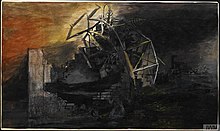
In many respects, the Victorian era continued until the outbreak of World War I in 1914, and the Royal Academy became increasingly ossified; the unmistakably late Victorian figure of
Walter Sickert and the Camden Town Group developed an English style of Impressionism and Post-Impressionism with a strong strand of social documentary, including Harold Gilman, Spencer Frederick Gore, Charles Ginner, Robert Bevan, Malcolm Drummond and Lucien Pissarro (the son of French Impressionist painter Camille Pissarro).[77] Where their colouring is often notoriously drab, the Scottish Colourists indeed mostly used bright light and colour; some, like Samuel Peploe and John Duncan Fergusson, were living in France to find suitable subjects.[78] They were initially inspired by Sir William McTaggart (1835–1910), a Scottish landscape painter associated with Impressionism.
The reaction to the horrors of the First World War prompted a return to pastoral subjects as represented by
Henry Moore emerged after
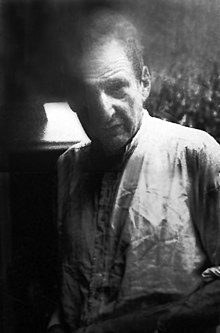
According to William Grimes of
In the 1950s, the London-based
In the 1960s,
-
John Duncan Fergusson, People and Sails at Royan, 1910
-
Sir Jacob Epstein Oscar Wilde's tomb, 1911, in Père Lachaise Cemetery
-
Roger Fry, River with Poplars, c. 1912
-
Spencer Gore of the Camden Town Group, Gauguins and Connoisseurs at the Stafford Gallery, 1911
-
James Bolivar Manson, Lucien Pissarro Reading c. 1913
-
David Bomberg, The Mud Bath, 1914
-
Paul Nash, The Ypres Salient at Night, 1917–18, he painted some of the most powerful images of World War I by an English artist.[100]
-
Dora Carrington, Portrait of E. M. Forster, 1924–1925
-
Henry Moore, Two Piece Reclining Figure No. 5, Bronze, 1963–1964
-
Sir Anthony Caro, Black Cover Flat (1974)
Contemporary art

The
In 1999, the Stuckists figurative painting group which includes Billy Childish and Charles Thomson was founded as a reaction to the YBAs.[103] In 2004, the Walker Art Gallery staged The Stuckists Punk Victorian, the first national museum exhibition of the Stuckist art movement.[104] The Federation of British Artists hosts shows of traditional figurative painting.[105] Jack Vettriano and Beryl Cook have widespread popularity, but not establishment recognition.[106][107][108] Banksy made a reputation with street graffiti and is now a highly valued mainstream artist.[109]
Antony Gormley produces sculptures, mostly in metal and based on the human figure, which include the 20 metres (66 ft) high Angel of the North near Gateshead, one of the first of a number of very large public sculptures produced in the 2000s, Another Place, and Event Horizon. The Indian-born sculptor Anish Kapoor has public works around the world, including Cloud Gate in Chicago and Sky Mirror in various locations; like much of his work these use curved mirror-like steel surfaces. The environmental sculptures of British land artist Andy Goldsworthy have been created in many locations around the world. Using natural found materials they are often very ephemeral, and are recorded in photographs of which several collections in book form have been published.[110] Grayson Perry works in various media, including ceramics. Whilst leading printmakers include Norman Ackroyd, Elizabeth Blackadder, Barbara Rae and Richard Spare.
See also
- Art of Birmingham
- Bristol School
- List of artists from Northern Ireland
- List of Scottish artists
- List of Welsh artists
- Art UK
- Courtauld Institute of Art
- Dulwich Picture Gallery
- National Portrait Gallery
- Tate Britain
- Walker Art Gallery
- Whitechapel Art Gallery
- The Priseman Seabrook Collection
- British Marine Art (Romantic Era)
- List of equestrian statues in the United Kingdom
- List of Turner Prize winners and nominees
- London Art Fair
References
- ^ Strong (1999), 9–120, or see the references at the linked articles
- ^ Waterhouse, Chapters 1-6
- ^ Waterhouse, 152
- ^ Waterhouse, 138–139; 151; 163
- ^ Waterhouse, 135–138; 147–150
- ^ Waterhouse, 131–133. The "objections" included that it was a dark night, the boat was small, the king not smartly dressed, and many of the nobles who accompanied him were by then out of favour.
- ^ Waterhouse, 132–133; Pevsner, 29–30
- ^ Strong (1999), 358-361
- ^ Waterhouse, 165; 168–179
- ^ Waterhouse, 164–165
- ^ Waterhouse, 200-210
- ^ Waterhouse, 155–156
- ^ Waterhouse, 153–154, 157–160
- ^ Waterhouse, 163–164
- ^ Snowdin, 278-287, and see Index.
- ^ Snodin, 100–106
- ^ Snodin, 214-215
- ^ Strong (1999), Chapter 24
- ^ Pevsner, 172
- ^ Snodin, 15–17; 29–31 and throughout.
- ^ Reitlinger, 58 (quote), 59-75
- ^ Waterhouse, 217-230
- ^ Waterhouse, 164–165, 225–227, and see Index.
- ^ Waterhouse, 227-230
- ^ Waterhouse, Chapter 18; Piper, 54-56; Mellon, 82
- ^ Waterhouse, 306-311
- ^ Piper, 84; Reitlinger, 434-437 with the remarkable numbers
- ^ Waterhouse, 311-316
- ^ Reitlinger, 74-75; Waterhouse, 232-241
- ^ Pevsner, 159
- ^ Strong (1999), 478-479; Waterhouse, Chapter 20
- ^ Egerton, 332-342; Waterhouse, 285-289
- ^ Waterhouse, 315-322
- ^ Waterhouse, 327-329
- ^ Griffiths, 49, Chapter 6
- ^ snowdin, 236–242
- ^ Snodin, 154–157
- ^ Stephen Adams, The Telegraph, September 22, 2009, JMW Turner's feud with John Constable unveiled at Tate Britain Retrieved 9 December 2010
- ^ Jack Malvern, The Sunday Times, September 22, 2009, Tate Britain exhibition revives Turner and Constable’s old rivalry Retrieved 9 December 2010
- ^ "J.M.W. Turner, the Original Artist-Curator – Look Closer". Tate.
- ^ Constable's Great Landscapes: The Six-Foot Paintings, National Gallery of Art, Washington, DC Retrieved 9 December 2010
- ^ Pevsner, 161–164; Mellon, 134; Tate 2006 Constable exhibition Tate Britain feature.
- ^ Piper, 116
- ^ Piper, 127–129
- ^ Dictionary of women artists Retrieved 8 December 2010
- ^ Shirley Dent and Jason Whittaker. Radical Blake: Influence and Afterlife from 1827. Houndmills: Palgrave, 2002.
- ^ Neil Spencer, The Guardian, October 2000, Into the Mystic, an homage to the written work of William Blake. Retrieved 8 December 2010
- ^ Piper, 96-98; Waterhouse, 330
- ^ Piper, 135
- ^ Piper, 84
- ^ Reitlinger, 97
- ^ Piper, 139–146; Wilson, 79–81
- ^ Piper, 149; Strong (1999), 540–541; Reitlinger, 97–99, 148–151 and elsewhere; he has detail throughout on reproduction rights.
- ISBN 978-0-300-12190-2
- Homburg [1].
- ^ Piper, 131
- ^ Strong (1978), throughout. See Appendix I for a revealing full listing of pictures shown at the RA 1769–1904, analysed by subject
- ^ Strong (1978), 47-73
- ^ Conrad, Peter. The Victorian Treasure House
- ^ Fletcher, throughout
- ^ Piper, 148–151
- ^ a b Whistler versus Ruskin, Princeton edu. Archived 16 June 2010 at the Wayback Machine Retrieved 13 June 2010
- ^ a b [2] Archived 12 January 2012 at the Wayback Machine, from the Tate, retrieved 12 April 2009
- ^ Wilson, 89-91; Rosenthal, 144, 160–162; Reitlinger, 156–157
- ^ Frayling, 12-64
- ^ Hamilton, 57-62; Wilson, 97-99
- ^ Hamilton, 146–148
- ISBN 1-880908-70-0.
- ^ "See The Correspondence of James McNeill Whistler". Archived from the original on 20 September 2008.
- ^ Peter Stansky's review of Linda Merill's A Pot of Paint: Aesthetics on Trial in Whistler v. Ruskin in the Journal of Interdisciplinary History, Vol. 24, No. 3 (Winter, 1994), pp. 536-537 [3]
- ^ a b McKenzie, John, Art and Empire, britishempire.co.uk, retrieved 24 October 2008
- ^ Barringer et al 2007, p. 3.
- ^ Gothic Revival Feature from the Victoria and Albert Museum
- ^ Voysey wallpaper, V&A Museum
- ^ a b Jenkins et al 2005, p. 5.
- ^ Wilson, 127–129; Mellon, 182–186
- ^ Camden Town Group, Tate Retrieved 7 December 2010
- ^ Scottish Colourists, Tate Retrieved 14 December 2010
- ^ "Stanley William Hayter (1901 − 1989)". Art Collection. British Council. Archived from the original on 15 July 2010. Retrieved 5 October 2010.
- ^ Brenson, Michael (6 May 1988). "Stanley William Hayter, 86, Dies; Painter Taught Miró and Pollock". The New York Times. Retrieved 18 October 2008.
- ^ Walker, 219-225
- ^ "Lucian Freud, Figurative Painter Who Redefined Portraiture, Is Dead at 88". The New York Times. 21 July 2011.
- ^ "The Bronze Age Archived 5 January 2012 at the UK Government Web Archive". Tate Magazine, Issue 6, 2008. Retrieved on 9 December 2010.
- ^ Alan Davie, Tate Retrieved 15 December 2010
- ^ Walker, 211-217
- ^ a b Livingstone, M., (1990), Pop Art: A Continuing History, New York: Harry N. Abrams, Inc.
- ^ Arnason, H., History of Modern Art: Painting, Sculpture, Architecture, New York: Harry N. Abrams, Inc. 1968.
- ^ This is Tomorrow 1956 catalog Archived 10 July 2010 at the Wayback Machine Retrieved 9 December 2010
- ^ Anthony Caro Exhibition 2005, Tate Britain Retrieved 9 December 2010
- ^ May 2006, Sunday Times obituary Retrieved 9 December 2010
- ^ ISC Lifetime Achievements Award in Sculpture Retrieved 9 December 2010
- ^ tate.org.uk Archived 11 January 2012 at the Wayback Machine Retrieved 9 December 2010
- ^ Ian Stephenson Biography New Art Centre Retrieved 9 December 2010
- ^ Ian Stephenson 1934 - 2000 Tate website Retrieved 9 December 2010
- ^ Tate Collection Retrieved 9 December 2010
- ^ William Tillyer Retrieved 15 January 2018]
- ^ "Colorscope: Abstract Painting 1960–1979". Santa Barbara Museum of Art. 2010. Archived from the original on 3 July 2010. Retrieved 9 December 2010.
- ^ Tate Biography Retrieved December 2010
- ^ Irish Museum of Modern Art Website Archived 21 May 2009 at the Wayback Machine Retrieved 9 December 2010
- ^ Gough, Paul (2010). A Terrible Beauty: British Artists in the First World War. pp. 127–164.
- ^ Barringer et al 2007, p. 17.
- ^ "Sensation sparks New York storm", BBC, 23 September 1999. Retrieved 17 October 2008.
- ^ Cassidy, Sarah. "Stuckists, scourge of BritArt, put on their own exhibition", The Independent, 23 August 2006. Retrieved 6 July 2008.
- ^ Moss, Richard. "Stuckist's Punk Victorian gatecrashes Walker's Biennial, Culture24, 17 September 2004. Retrieved 3 December 2009.
- ^ "Major new £25,000 Threadneedle art prize announced to rival Turner Prize", 24 Hour Museum, 5 September 2007. Retrieved 7 July 2008.
- ^ Smith, David. "He's our favourite artist. So why do the galleries hate him so much?", The Observer, 11 January 2004. Retrieved 7 July 2008.
- ^ Campbell, Duncan. "Beryl Cook, artist who painted with a smile, dies", The Guardian, 29 May 2008. Retrieved 7 July 2008.
- ^ "Painter Beryl Cook dies aged 81" BBC, 28 May 2008. Retrieved 7 July 2008.
- ^ Reynolds, Nigel. "Banksy's graffiti art sells for half a million", The Daily Telegraph, 25 October 2007. Retrieved 7 July 2008.
- ^ Adams, Tim (11 March 2007). "The Interview: Andy Goldsworthy". The Observer – via www.theguardian.com.
Sources
- Barringer, T. J.; Quilley, Geoff; Fordham, Douglas (2007), Art and the British Empire, Manchester University Press, ISBN 978-0-7190-7392-2
- Egerton, Judy, National Gallery Catalogues (new series): The British School, 1998, ISBN 1-85709-170-1
- Fletcher, Pamela, Narrating Modernity: The British Problem Picture, 1895–1914, Ashgate, 2003
- ISBN 0-7126-1820-1
- Griffiths, Antony (ed), Landmarks in Print Collecting: Connoisseurs and Donors at the British Museum since 1753, 1996, British Museum Press, ISBN 0-7141-2609-8
- Hamilton, George Heard, Painting and Sculpture in Europe, 1880-1940 (Pelican History of Art), Yale University Press, revised 3rd edn. 1983 ISBN 0-14-056129-3
- Hughes, Henry Meyric and Gijs van Tuyl (eds.), Blast to Freeze: British Art in the 20th Century, 2003, Hatje Cantz, ISBN 3-7757-1248-8
- Jenkins, Adrian; Marshall, Francis; Winch, Dinah; Morris, David (2005). Creative Tension: British Art 1900-1950. Paul Holberton. ISBN 978-1-903470-28-2.
- "Mellon": Warner, Malcolm and Alexander, Julia Marciari, This Other Eden, British Paintings from the Paul Mellon Collection at Yale, Yale Center for British Art/Art Exhibitions Australia, 1998
- Parkinson, Ronald, ISBN 0-11-290463-7
- Pevsner, Nikolaus. The Englishness of English Art, Penguin, 1964 edn.
- Piper, David, Painting in England, 1500–1880, Penguin, 1965 edn.
- Reitlinger, Gerald; The Economics of Taste, Vol I: The Rise and Fall of Picture Prices 1760-1960, Barrie and Rockliffe, London, 1961
- Rosenthal, Michael, British Landscape Painting, 1982, Phaidon Press, London
- Snodin, Michael (ed). Rococo; Art and Design in Hogarth's England, 1984, Trefoil Books/ISBN 0-86294-046-X
- "Strong (1978)": ISBN 0-500-27132-1(Recreating the past .... in US; Painting the Past ... in 2004 edition)
- "Strong (1999)": ISBN 1-85681-534-X
- ISBN 0-300-05319-3
- Wilson, Simon; Tate Gallery, An Illustrated Companion, 1990, Tate Gallery, ISBN 9781854370587
- Andrew Wilton & Anne Lyles, The Great Age of British Watercolours, 1750–1880, 1993, Prestel, ISBN 3-7913-1254-5

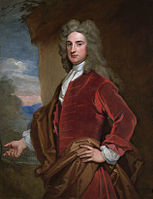










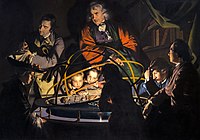






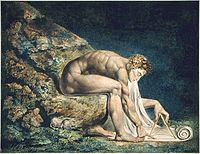
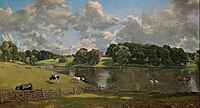







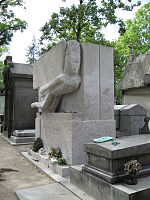




![Paul Nash, The Ypres Salient at Night, 1917–18, he painted some of the most powerful images of World War I by an English artist.[100]](http://upload.wikimedia.org/wikipedia/commons/thumb/5/5b/The_Ypres_Salient_at_Night_Art.IWMART1145.jpg/200px-The_Ypres_Salient_at_Night_Art.IWMART1145.jpg)


